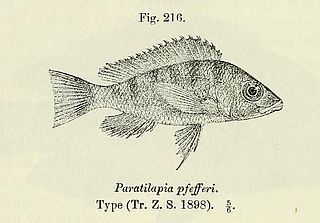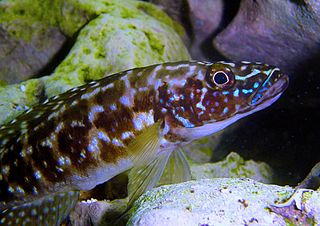Related Research Articles

Anomalochromis is a genus of fish in the family Cichlidae, containing the single species Anomalochromis thomasi, the African butterfly cichlid. It is a small cichlid growing to a length of 6–8 centimetres (2.4–3.1 in). The natural habitat of A. thomasi is Sierra Leone, Liberia and Guinea, mainly in smaller streams. The fish are typically found in slightly acidic, oxygen rich water with other west African cichlid genera such as Hemichromis and Pelvicachromis.

Amphilophus is a genus of cichlid fishes from Central America, ranging from southern Mexico to Panama. The genus currently contains 23 species, including several that are well-known from the aquarium trade. However, studies led by Oldrich Říčan in 2008 and 2016 suggested that several species within Amphilophus should be moved to the genus Astatheros. Species proposed to be moved to Astatheros in 2008 were A. alfari, A. altifrons, A. bussingi, A. diquis, A. longimanus, A. macracanthus, A. margaritifer, A. rhytisma, A. robertsoni and A. rostratus. Further genetic studies led Říčan to put A. macracanthus in Astatheros, but to put A. alfari, A. altifrons, A. bussingi, A. diquis, A. longimanus, A. rhytisma, A. robertsoni and A. rostratus within the genus Cribroheros. Říčan's study suggests that the Astatheros species are more closely related to the Jack Dempsey and rainbow cichlid than to the remaining Amphilophus species.

The giant cichlid, also known as the emperor cichlid, is a species of fish in the family Cichlidae, endemic to Lake Tanganyika in Africa. It is the only member of its genus Boulengerochromis and tribe Boulengerochromini.
Barton's cichlid, is a species of cichlid endemic to Mexico where it occurs in the basin of the Panuco River where it can be found in lagoons and rivers. This species can reach a length of 18 centimetres (7.1 in) SL. It can also be found in the aquarium trade. The specific name honours the author, Tarleton Hoffman Bean's brother, Barton Appler Bean (1860–1947), who was assistant curator of Ichthyology at the United States National Museum.

The Minckley's cichlid is a species of fish in the family Cichlidae. It is endemic to Cuatro Ciénegas in Coahuila, Mexico. The specific name honours the ichthyologist Wendell L. Minckley (1935-2001) of Arizona State University who studied the ecology of Cuatro Ciénegas.

Gnathochromis pfefferi is an African species of fish in the family Cichlidae. It is endemic to Lake Tanganyika and its slow-flowing tributaries in the countries of Burundi, the Democratic Republic of the Congo, Tanzania and Zambia. It is common and widespread. This cichlid is found in relatively shallow waters, typically over soft bottoms in places with aquatic grasses.

Lepidiolamprologus kendalli is a species of cichlid endemic to Lake Tanganyika preferring rocky areas. This carnivorous species preys upon fish. This species can reach a length of 18 centimetres (7.1 in) TL. It can also be found in the aquarium trade. The specific name honours the American fish ecologist Robert L. Kendall, who collected the type.

The damba is a species of cichlid.

The kotsovato is a species of cichlid from northwestern Madagascar. As presently defined its range spans several river basins, but this could possibly include more than one species. It is threatened by habitat loss and competition from introduced species. This relatively elongate Paretroplus reaches about 16 centimetres (6.3 in) in length and is closely related to P. gymnopreopercularis, which it resembles. The specific name honours the French fisheries scientist André Kiener.
Paretroplus nourissati, the lamena, is a species of cichlid from the vicinity of the confluence of the Amboaboa and Mangarahara Rivers near Mandritsara in northern Madagascar. This relatively elongate Paretroplus reaches about 16 centimetres (6.3 in) in length, and is closely related to P. lamenabe and P.tsimoly. P. nourissati is threatened by habitat loss and invasive species.
The kotso is a species of cichlid fish from northwestern Madagascar. Currently rated as data deficient by the IUCN, this species is virtually unknown. The only known specimen is a juvenile that was collected more than 80 years ago. It is not entirely clear where it was collected, but likely from the Maintimaso River or Lake Ambanja, which both are part of the Betsiboka River drainage. Erroneously, the name P. petiti has often been applied to members of a different species, P. dambabe. The specific name honours the French zoologist and anatomist Georges Petit (1892-1973) of the Muséum national d’Histoire naturelle, who collected type.
The threadfin cichlid is a species of cichlid endemic to Lake Tanganyika found in areas with rocky substrates on which it can graze on algae. This species can reach a length of 18 cm (7.1 in). It can be found in the aquarium trade. The specific name of this cichlid honours the British ichthyologist Ethelwynn Trewavas (1900-1993).

Ptychochromis grandidieri is a species of fish in the family Cichlidae endemic to river basins along a large part of the eastern coast of Madagascar, although it has been recorded as far as 100 km (62 mi) inland. Uniquely in the genus Ptychochromis, this species also occurs in brackish water. It reaches 21.3 cm (8.4 in) in standard length. It shares a large part of its range with a cichlid from another genus, Paretroplus polyactis. The specific name honours Alfred Grandidier (1836-1921), the French naturalist and explorer who, with Henri Joseph Léon Humblot (1852-1914), collected the type.
Rhamphochromis woodi is a species of piscivorous cichlid endemic to Lake Malawi where it prefers open waters at depths of from 8 to 121 metres. This species can reach a length of 42 centimetres (17 in) TL. It can also be found in the aquarium trade. The specific name honours Rodney C. Wood, whose collection of cichlids from Lake Malawi, which included the type of this species, was presented to the British Museum.

Stigmatochromis woodi is a species of cichlid endemic to Lake Malawi where it can be found hunting for prey over sandy areas. It can reach a length of 25 centimetres (9.8 in) TL. It can also be found in the aquarium trade. The specific name honours Rodney C. Wood, whose collection of cichlids from Lake Malawi, which included the type of this species, was presented to the British Museum. It is the type species of the genus Stigmatochromis.
Paretroplus loisellei is a vulnerable species of cichlid fish from the Mahanara River basin north of Sambava in northeastern Madagascar. Until its scientific description in 2011, this population was usually referred to as Paretroplus sp. nov. "Ventitry" or included in P. damii, which it resembles. It reaches about 15 centimetres (5.9 in) in length, and is threatened by habitat loss and introduced species. The similar named Ptychochromis loisellei is also restricted to the Mahanara River basin. The specific name honours Paul V. Loiselle, Emeritus Curator of Freshwater Fishes at the New York Aquarium and a researcher in, and campaigner for the conservation of, the freshwater fish of Madagascar.
Rondonacara hoehnei is a species of cichlid fish of the subfamily Cichlinae. This species is endemic to the upper das Mortes River basin in the Araguaia drainage of central Brazil. This species is the only known member of its genus, but it was formerly included in Aequidens. Although not yet rated by the IUCN, it has been suggested that it is seriously threatened and should be considered critically endangered. The specific name honour the collector of the type specimen, the Brazilian botanist Frederico Carlos Hoehne (1882-1959).
Kihnichthys ufermanni, the Usumacinta cichlid, is a species of cichlid found in the Pasión River system, a tributary to the Usumacinta River in Petén, Guatemala. This species is the only known member of its genus, but several of its features, including the chisel-like teeth, are shared with Cincelichthys and whether they should be merged into a single genus is not yet fully resolved.
The bluemouth cichlid is a species of cichlid fish that is endemic to the Usumacinta River basin in southern Mexico and Guatemala. This species is the only known member of its genus. The specific name honours the French cichlid specialist Jean Claude Nourissat (1942-2003), who collected type of this species. It reaches up to 22 cm (8.7 in) in total length.
Darienheros calobrensis, is a species of cichlid found in Middle America. It is distributed in the Darién area of eastern Panamá on the Pacific slope in the Tuíra, Chucunaque and Bayano River basins. This species is the only known member of its genus. The specific name alludes to the Rio Calobre, the type locality.
References
- 1 2 Froese, Rainer and Pauly, Daniel, eds. (2019). "Astatheros macracanthus" in FishBase . July 2019 version.
- ↑ Říčan, O., Piálek, L., Dragová, K., and Novák, J. (2016). Diversity and evolution of the Middle American cichlid fishes (Teleostei: Cichlidae) with revised classification. Vertebrate Zoology 66 (1): 1-102.